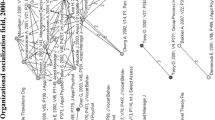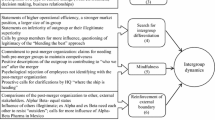Abstract
We examine the role of social interactions between employees of two firms in a post-acquisition context on their identification with two relevant loci of identification: the pre-acquisition unit and the acquirer group. We used a mixed methods longitudinal design to understand how social interaction foster dual identification. Quantitative results show that social interactions foster identification with the pre-acquisition unit and with the acquirer. Moreover, qualitative results give a finer-grained vision of social interactions. We show that situated identification develops thanks to joint objectives, deadlines, quick wins and contribution to the whole group. This paper contributes to the literature on organizational identification specifying the effects of an understudied antecedent on two loci of identification. It also contributes to the literature on the management of the post-acquisition integration process empirically confirming that social interactions are favorable in the integration process.
Similar content being viewed by others
References
Agrawal, A. and Jaffe, J. (2000) ‘The post merger performance puzzle’, Advances in Mergers and Acquisitions, 1, 119–156.
Ashforth, B.E., Harrison, S.H. and Corley, K.G. (2008) ‘Identification in organizations: An examination of four fundamental questions’, Journal of Management, 34 (3), 325–374.
Ashforth, B.E. and Johnson, S.A. (2001) ‘Which hat to wear? The relative salience of multiple identities in organizational contexts’, in M.A. Hogg and D.J. Terry (eds.), Social Identity Processes in Organizational Contexts, Psychology Press, Philadelphia, PA, pp. 31–48.
Ashforth, B.E. and Mael, F. (1989) ‘Social identity theory and the organization’, Academy Of Management Review, 14 (1), 20–39.
Bartels, J., Douwes, R., De Jong, M. and Pruyn, A. (2006) ‘Organizational identification during a merger: Determinants of employees’ expected identification with the new organization’, British Journal of Management, 17 (3), 49–67.
Bartels, J., Pruyn, A. and de Jong, M. (2009) ‘Employee identification before and after an internal merger: A longitudinal analysis’, Journal of Occupational & Organizational Psychology, 82 (1), 113–128.
Benkhoff, B. (1997) ‘Better performance through organizational identification: a test of outcomes and antecedents based on social identity theory' in J. Wickham (ed.), The Search for Competitiveness and Its Implications for Employment, Oak Tree Press, Dublin, pp. 159–179.
Birkinshaw, J., Bresman, H. and Hakanson, L. (2000) ‘Managing the post-acquisition integration process: How the human integration and task integration processes interact to foster value creation’, Journal of Management Studies, 37 (3), 395–425.
Bjørkman, I., Stahl, G.K. and Vaara, E. (2007) ‘Cultural differences and capability transfer in cross-border acquisitions: The mediating roles of capability complementarity, absorptive capacity, and social integration’, Journal of International Business Studies, 38 (4), 658–672.
Blake, R.R. and Mouton, J.S. (eds.) (1984) ‘How to achieve integration on the human side of the merger’, in Solving Costly Organizational Conflicts: Achieving Intergroup Trust, Cooperation and Teamwork, Jossey-Bass, San Francisco.
Brewer, M.B. (1991) ‘The social self: On being the same and different at the same time’, Personality and Social Psychology Bulletin, 17 (5), 475–482.
Cartwright, S. and Cooper, C.L. (1993) ‘The psychological impact of merger and acquisition on the individual: A study of building society managers’, Human Relations, 46 (3), 327–347.
Cartwright, S. and Schoenberg, R. (2006) ‘Thirty years of mergers and acquisitions research: Recent advances and futures opportunities’, British Journal of Management, 17 (S1), 1–5.
Chow, G.C. (1960) ‘Tests of equality between sets of coefficients in two linear regression’, Econometrica, 28 (3), 591–605.
Citera, M. and Rentsch, J.R. (1993) ‘Is there justice in organizational acquisitions? The role of procedural and distributive fairness in corporate acquisitions’, in R. Cropanzano (ed.), Justice in the Workplace: Approaching Fairness in Human Resource Management, Erlbaum, Hillsdale, NJ, pp. 211–230.
Clark, S.M., Gioia, D.A., Ketchen, J.D.J. and Thomas, J.B. (2010) ‘Transitional identity as a facilitator of organizational identity change during a merger’, Administrative Science Quarterly, 55 (3), 397–438.
Corley, K. and Gioia, D. (2004) ‘Identity ambiguity and change in the wake of corporate spin-off’, Administrative Science Quarterly, 49 (2), 173–208.
Dutton, J.E., Dukerich, J.M. and Harquail, C.V. (1994) ‘Organizational images and members identification’, Administrative Science Quarterly, 39 (2), 239–263.
Fiol, C.M. (2002) ‘Capitalizing on paradox: The role of language in transforming organizational identities’, Organization Science, 13 (6), 653–666.
Gaertner, S.L., Dovidio, J.F. and Bachman, B.A. (1996) ‘Revisiting the contact hypothesis: The induction of a common group identity’, International Journal of Intercultural Relations, 20 (3–4), 271–290.
Giessner, S.R., Tendayi Viki, G., Otten, S., Terry, D.J. and Täuber, S. (2006) ‘The challenge of merging: Merger patterns, premerger status, and merger support’, Personality and Social Psychology Bulletin, 32 (3), 339–352.
Gleibs, I.H., Mummendey, A.l. and Noack, P. (2008) ‘Predictors of change in postmerger identification during a merger process: A longitudinal study’, Journal of Personality & Social Psychology, 95 (5), 1095–1112.
Hall, D.T., Schneider, B. and Nygren, H.T. (1970) ‘Personal factor in organizational identification’, Administrative Science Quarterly, 15 (2), 176–190.
Haspeslagh, P.C., and Jemison, D.B. (1991) Managing Acquisitions. Creating Value through Corporate Renewal, The Free Press, New York, p. 416.
Hoelter, J.W. (1985) ‘A structural theory of personal consistency’, Social Psychology Quarterly, 48 (2), 118–129.
Hogg, M.A. and Terry, D.J. (2000) ‘Social identity and self-categorisation processes in organizational contexts’, Academy of Management Review, 25 (1), 121–140.
Hornsey, M.J. and Hogg, M.A. (2000) ‘Assimilation and diversity: An integrative model of subgroup relations’, Personality and Social Psychology Review, 4 (2), 143–156.
Jacobs, G., Christe-Zeyse, J., Keegan, A. and Pólos, L. (2008) ‘Reactions to organizational identity threats in times of change: Illustrations from the German police’, Corporate Reputation Review, 11 (3), 245–261.
Jick, T.D. (1979) ‘Mixing qualitative and quantitative methods: Triangulation in action’, Administrative Science Quarterly, 24 (4), 602–611.
Kramer, R.M. (1991) ‘Intergroup relations and organizational dilemmas’, Research in Organizational Behavior, 13, 191–228.
Larsson, R. and Finkelstein, S. (1999) ‘Integrating strategic, organizational and human resources perspectives on mergers and acquisitions: A case survey of synergy realization’, Organization Science, 10 (1), 1–26.
Lee, S.M. (1971) ‘An empirical analysis of organization identification’, Academy of Management Journal, 14 (2), 213–226.
Mael, F. (1988) Organizational Identification: Construct Redefinition and a Field Application with Organizational Alumini, Wayne State University, Detroit, MI.
Mael, F. and Ashforth, B.E. (1992) ‘Alumini and their alma mater: A partial test of the reformulated model of organizational identification’, Journal of Organizational Behaviour, 13 (2), 103–123.
Mael, F. and Ashforth, B.E. (1995) ‘Loyal from day one: Biodata, organizational identification, and turnover among newcomers’, Personnel Psychology, 48 (2), 309–333.
Mael, F.A. and Tetrick, L.E. (1992) ‘Identifying organizational identification’, Educational and Psychological Measurement, 52 (2), 813–824.
Michel, A., Stegmaier, R. and Sonntag, K. (2010) ‘I scratch your back – You scratch mine. Do procedural justice and organizational identification matter for employees’ cooperation during change?’ Journal of Change Management, 10 (1), 41–59.
O'Reilly, C. and Chatman, J. (1986) ‘Organizational commitment and psychological attachment: The effect of compliance, identification and internalization on prosocial behavior’, Journal of Applied Psychology, 7 (3), 492–499.
Osborne, J.W. and Waters, E. (2002) ‘Four assumptions of multiple regression that researchers should always test’, Practical Assessment, Research & Evaluation, 8 (2), 1–5.
Podsakoff, P.M., MacKenzie, S.B. and Podsakoff, N.P. (2003) ‘Common method biases in behavioral research: A critical review of the literature and recommended remedies’, Journal of Applied Psychology, 88 (5), 879–903.
Pratt, M.G. and Foreman, P.O. (2000) ‘Classifying managerial responses to multiple organizational identities’, Academy of Management Review, 25 (1), 18–42.
Rousseau, D. (1998) ‘Why workers still identify with organizations’, Journal of Organizational Behaviour, 19 (3), 217–233.
Rouzies, A. (2011) ‘Antecedents of employees’ identification with a merger: A three-stage empirical study’, International Studies of Management and Organizations, 41 (3), 29–48.
Scherif, M. and Scherif, C.W. (1969) Social Psychology, Harper and Row, New York.
Schneider, B., Hall, D.T. and Nygren, H.T. (1971) ‘Self image and job characteristics as correlates of changing organizational identification’, Human Relations, 24 (5), 397–416.
Shrivastava, P. (1986) ‘Postmerger integration’, Journal of Business Strategy, 7 (1), 65–76.
Tabachnick, B.G. and Fidell, L.S (2001) Applied multivariate analyses for the social sciences, 4th edn., HarperCollins, New York.
Tajfel, H. and Turner, J.C. (1979) ‘An integrative theory of intergroup conflict’, in W.G. Austin and S. Worchel (eds.), The Social Psychology of Intergroup Relations, Nelson, Chicago, pp. 33–47.
Tajfel, H. and Turner, J.C. (1986) ‘The social identity theory of intergroup behavior’, in W.G. Austin and S. Worchel (eds.), Psychology of Intergroup Relations, Nelson, Chicago, pp. 7–24.
Tashakkori, A. and Teddlie, C. (2003) Handbook of Mixed-Methods in Social & Behavioral Research, Sage, Thousand Oaks, CA.
Tyler, T.R. (1999) ‘Why people cooperate with organizations: An identity-based perspective’, in J. Press (ed.), Research in Organizational Behavior, JAI Press, Greenwich, CT, pp. 201–246.
Ullrich, J., Wieseke, J. and Van Dick, R. (2005) ‘Continuity and change in mergers and acquisitions: A social identity case study of a German industrial merger’, The Journal of Management Studies, 42 (8), 1549.
Van Dick, R., Ullrich, J. and Tissington, P.A. (2006) ‘Working under a black cloud: How to sustain organizational identification after a merger’, British Journal of Management, 17 (1), 69–79.
Van Dick, R., Wagner, U. and Lemmer, G. (2004) ‘Research note: The winds of change – Multiple identifications in the case of organizational mergers’, European Journal of Work and Organizational Psychology, 13 (2), 121–138.
Van Knippenberg, D., Van Knippenberg, V., Monden, S. and De Lima, F. (2002) ‘Organizational identification after a merger: A social identity perspective’, British Journal of Social Psychology, 41 (2), 233–252.
Van Knippenberg, D. and Van Leeuwen, E. (2001) ‘Organizational identity after a merger: Sense of continuity as the key to postmerger identification’, in M.A. Hogg and D.J. Terry (eds.), Social Identity Processes in Organizational Contexts, Psychology Press, Philadelphia, pp. 249–264.
Vora, D. and Kostova, T. (2007) ‘A model of dual organizational identification in the context of the multinational enterprise’, Journal of Organizational Behavior, 28 (3), 327–350.
Vora, D., Kostova, T. and Roth, K. (2007) ‘Roles of subsidiary managers in multinational corporations: The effect of dual organizational identification’, Management International Review, 47 (4), 595–620.
Author information
Authors and Affiliations
Rights and permissions
About this article
Cite this article
Rouzies, A., Colman, H. Identification Processes in Post-Acquisition Integration: The Role of Social Interactions. Corp Reputation Rev 15, 143–157 (2012). https://doi.org/10.1057/crr.2012.8
Published:
Issue Date:
DOI: https://doi.org/10.1057/crr.2012.8




